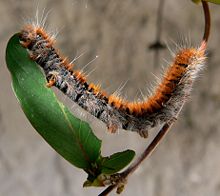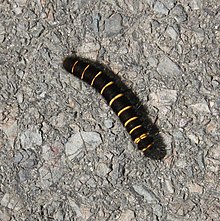Blackberry moth
| Blackberry moth | ||||||||||||
|---|---|---|---|---|---|---|---|---|---|---|---|---|

Blackberry moth ( Macrothylacia rubi ), female |
||||||||||||
| Systematics | ||||||||||||
|
||||||||||||
| Scientific name | ||||||||||||
| Macrothylacia rubi | ||||||||||||
| ( Linnaeus , 1758) |

The Brombeerspinner ( Macrothylacia rubi ) is a butterfly ( moth ) from the family of clucking (Lasiocampidae).
features
The moths reach a wingspan of 38 to 68 millimeters. The females have gray-brown forewings, the males red-brown or gray-brown. Both wear two narrow, pale yellowish bars. In between, the wing color of the males is a little lighter.
The caterpillars are about 80 millimeters long. They are initially black, with bright yellow or orange incisions and have a few long, light gray hairs. In old age they are significantly darker due to their thick, black and reddish brown hair. But they still have light gray hair on the sides.
Occurrence
The animals are found all over Europe , except in the far north and parts of the Mediterranean region , east to Central Asia . They are the most common type of chuckling in Central Europe . They are found in a wide variety of open, both dry and humid areas, such as. B. on dry grass , on embankments, on meadows at forest edges and in moors .
Way of life
The females are active at twilight and at night and are attracted to artificial light sources early on. The males fly around wildly in the late afternoon and at dusk just above the vegetation and in a very fast zigzag flight to track down females ready to mate.
Flight and caterpillar times
The moths fly in one generation from mid-May to July. The caterpillars can be found from August and after wintering until April.
Food of the caterpillars
The caterpillars eat the leaves of numerous shrubs and herbaceous plants such as. B. Blackthorn ( Prunus spinosa ), raspberry ( Rubus idaeus ), blackberries ( Rubus fruticosus ), yellow sun rose ( Helianthemum nummularium ), small meadow button ( Sanguisorba minor ), winged broom ( Genista sagittalis ), clover ( Trifolium ), sweet peas ( Vicia ) and Ribwort plantain ( Plantago lanceolata ).
development
The females glue their 2.5 millimeter long eggs close to the ground, but also up to a maximum of 1.5 meters in height, in groups around stems. The eggs are oval, light cream-colored, have a dark point at the pole and therefore a light brown, circular pattern. The caterpillars are loners and hide under stones during the day. In the evening they climb up the vegetation. You can see them occasionally in late summer when crossing roads or open areas with no vegetation. If you sense danger, curl up and stay in this position for minutes. Your hair can cause allergic reactions to touch. They crawl fully developed from the end of August and hibernate before they pupate in a gray, tubular web in spring without eating again. Sometimes you can find them on warm days, very early in the year, in search of a suitable pupation place.
swell
Individual evidence
- ↑ a b c d Heiko Bellmann : The new cosmos butterfly guide. Butterflies, caterpillars and forage plants. Franckh-Kosmos, Stuttgart 2003, ISBN 3-440-09330-1 , p. 76.
- ^ A b c Hans-Josef Weidemann, Jochen Köhler: Moths. Weirdos and hawkers. Naturbuch-Verlag, Augsburg 1996, ISBN 3-89440-128-1 , p. 103ff.
- ↑ Manfred Koch : We identify butterflies. Volume 2: Bears, Spinners, Swarmers and Drills in Germany. 2nd, expanded edition. Neumann, Radebeul / Berlin 1964, DNB 452481929 , p. 94f.
Web links
- www.lepiforum.de
- Moths and Butterflies of Europe and North Africa (English)
- www.schmetterling-raupe.de
- Guide to the moths of Great Britain and Ireland (English)
- Macrothylacia rubi at Fauna Europaea






